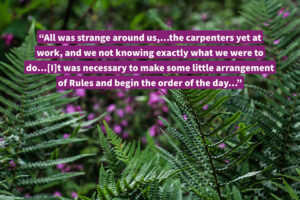July 31 marks the foundation day when Elizabeth Seton began the community in Emmitsburg.
By Regina Bechtle, SC

On a hot summer day in 1809, a group of women made their way to a lush valley in the rolling hills of northern Maryland, near the village of Emmitsburg. They had left Baltimore and their small school for girls on Paca Street, near St. Mary’s Seminary, where the Sulpician priests had offered them a temporary home. There the women had gathered, drawn by the magnetism of Elizabeth Ann Bayley Seton and her desire to live a life of prayer and service.
Elizabeth must have sensed that the Spirit was creating something new when she wrote from Baltimore in October, 1808, “It is expected I shall be the Mother of many daughters.” But how? She was a widow with five children and a Catholic convert of only four years. She had no experience of religious life such as it was lived by the semi-cloistered Ursulines in Quebec or the Carmelites in Port Tobacco, Maryland.
But gradually that dream took shape. A benefactor, Samuel Cooper, offered Elizabeth property in Emmitsburg where she and her companions could live a life in community, educate children and seek out those who lived in poverty. On June 21, 1809, she set out with her oldest daughter Anna Maria, her sisters-in-law Cecilia and Harriet Seton, and Maria Murphy from Philadelphia. When they arrived, they found their promised quarters not ready – a situation that would frequently recur in community history. Rev. John Dubois, then the local parish priest, temporarily gave them his small log cabin on St. Mary’s Mountain. Two weeks later Elizabeth’s daughters Catherine and Rebecca joined them.
A second contingent left Baltimore very early in the morning on July 30: Rose White, Cecilia O’Conway, Mary Ann Butler, Susan Clossy (from New York), Catherine Mullen, Ann Nabbs and two boarding students, accompanied by Elizabeth’s sons William and Richard. By then the first group had moved to their property where an old stone farmhouse awaited them. According to an account that Sr. Rose White wrote years later, the group arrived in Emmitsburg on the afternoon of July 31, ate a modest dinner, laid their mattresses on the floor of the Stone House, and no doubt slept soundly – but not long. The next day was Sunday; they had to rise early for confession and Mass in the parish and, as Sr. Rose later commented, “came home much fatigued.” She continued, “All was strange around us,…the carpenters yet at work, and we not knowing exactly what we were to do…[I]t was necessary to make some little arrangement of Rules and begin the order of the day…”
For the moment, a simple schedule, “Provisional Regulations for the St. Joseph Sisters,” was drawn up, presumably by Fr. Dubourg, the community’s first priest-superior. From the beginning, Elizabeth was recognized as their leader. Roles were assigned: Mother’s Assistant, Secretary and School Sister, Procuratrix, washer and baker. All took turns cooking and ironing; washing had to be done at nearby Tom’s Creek.
There was no precedent, no formal rule at first to guide this experiment, only the thoughts in the minds of the French-born Sulpician priests who drew on their memories of religious in France. Most familiar with the Daughters of Charity, they knew well their work on behalf of the poor. The Daughters’ well-ordered yet flexible rule, shaped by Vincent de Paul and Louise de Marillac for a radically new kind of religious community, had stood the test of nearly two centuries. It would be an excellent model for this group of women who came from various social backgrounds, with different levels of secular and religious knowledge and experience. Some were well-educated; others came with the artless devotion of simple hearts.
But it would take several more years for a copy of the Daughters’ rule to be brought from France, translated and adapted for the needs of a new Church in the new United States. Approved by Archbishop John Carroll in 1812, it would guide the Sisters of Charity for generations. July 31, 1809, is marked as the foundation day of the Sisters of Charity of St. Joseph’s, so named after the peaceful St. Joseph’s Valley in the shadow of St. Mary’s Mountain, as well as in honor of the foster father of Jesus.

How inspiring! Elizabeth and the women were so courageous. I just made leasing and moving arrangements and their story gives me the grace and confidence to move forward in a much different age. Thank you for sharing it for all of us in this 21st century.
What a story.inspiring. Never heard all of it before
Dear Regina,
A delightful narrative of the enthusiasm of beginning something new!
May we all continue in that spirit even though now we are all old and jaded.
Happy 212th Anniversary to all the Sisters of Charity.
Tom Fenlon
Thank You Regina for reminding us of this special anniversary
Thank you for this history of the Sisters of Charity and the beginnings of this Religious Community